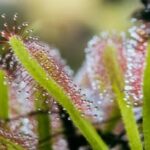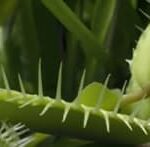As an Amazon Associate, this site earns commissions from qualifying purchases. For more details, click here.
Probably one of the first things you learned – or will learn – about Venus flytraps is that it grows in nutrient free soil. Since insects provide the nutrients Venus flytraps need, is soil even necessary? Can you grow these plants without dirt at all? Or does it still serve an important function for these carnivorous plants?
Venus flytraps use soil to stabilize its roots, which is necessary for the plant to grow. Soil also supplies water to the plant and serves as a repository for seeds.
What Soil Does For Venus Flytraps
Some plants can live without soil but Venus flytraps are not one of those. Soil does a lot of things for these plants, without which it cannot survive.
Because Venus flytraps grow in nutrient poor soil, some wonder if it is even necessary. After all if the plant gets its nutrients from insects, why bother with soil? While Venus flytraps get nutrients from bugs, soil is still important for many reasons.
Soil Anchors the Roots. Without soil, Venus flytrap roots will not be able to stand or spread out. Soil anchors roots to the surface so they can grow and stretch out. Dirt keeps roots in place so the plant can grow without toppling over.
Think of soil as a base that keeps Venus flytraps steady. You cannot stabilize a Venus flytrap in a pot without it. When you use the right soil mix, the dirt sticks to the roots so the plant does not get toppled by rain or wind.
Propagation. Seeds require soil to grow just like most plants. If you cut the flower stalk you can plant it in soil to grow another Venus flytrap. This is only possible with the right soil mixture.
Water Supplier. Water seeps into the soil and make their way into the roots. From there it spreads all over the plant, providing sustenance and energy. Combined with sunlight, air and nutrients and you have the ingredients for a healthy Venus flytrap.
Venus flytraps will only benefit from these if the soil is nutrient free. Regular potting soil can seriously weaken Venus flytraps or even kill it.
Since Venus flytraps grow in acid free soil, you have to simulate that environment. Do not worry about the nutrients as that is what the traps are for.
What Soil Should be Used with Venus Flytraps?
Long fiber sphagnum moss or peat moss are the most popular options. A 1:1 mixture of perlite and peat moss is ideal for Venus flytraps. Silica sand can also be used if perlite is not available.
Any type of peat moss will do provided it is not fortified or enhanced. If it is not enhance, it is suitable for Venus flytraps and other carnivorous plants. If you want your Venus flytrap to live a long time, use the right soil.
The nice thing about these soil mixes, peat moss in particular, is they are readily available. No matter which brand you buy, make certain it is not fertilized or enriched. You can also use silica sand if perlite is not available.
If you are a beginner, the 1:1 mix of perlite and peat moss is suitable. This soil combination works well for Venus flytraps and other carnivorous plants. Like we mentioned you can also use LFS such as Legigo Natural Sphagnum Moss to grow these plants.
How to Mix Peat Moss and Perlite
Get a large bucket and pour in the peat moss. Add perlite and some distilled water. Only use purified water as tap water has minerals which will harm the plant.
Be generous with the water as peat moss takes a while to mix. It helps to use warm water as peat moss takes longer to absorb cold. Just keep adding water and mixing until the perlite and peat moss are thoroughly combined.
You can also add some sphagnum moss to the perlite and peat mix. It is not necessary, but sphagnum does keep perlite in the mix instead of emerging atop the soil.
You can try other soil ratios once you have grown Venus flytraps in 1:1 mix. You can do a 5:3:2 mixture of peat moss, silica sand and perlite respectively. This soil mix stimulates root growth and improves aeration.
Will the Wrong Soil Mix Kill Venus Flytraps?
Throughout this guide we have emphasized the need to use the right soil mix. Specifically, use only nutrient free soil. If you use standard houseplant soil, it could kill your Venus flytrap.
This goes against what people do with typical household plants, but Venus flytraps are not your average plant.
If Venus flytraps already get nutrients from insects, there is no need for rich soil. It will overwhelm the plant plus their roots are not designed to handle nutrients.
The origins of Venus flytraps are unknown, but scientists do know they can only live in poor soil. Why this is so is unclear, but that has always been the case.
Nutrient poor soil will kill most plants so in order to live, Venus flytraps grew traps. These traps are equipped with nectar to lure bugs that contain the nutrients they need.
If the ground does not have the nutrients the Venus flytrap requires, it will get them elsewhere. In this case insects.
Rich, fertilized soil cannot be used as a substitute for insect food. Venus flytraps absorb nutrients through their traps, not the soil. Depriving them of nutrients in favor of fertilized soil will kill it.
When Venus flytraps eat bugs, they dissolve it to absorb the nutrients. These are turned into amino acids and other substances the plant uses to stimulate growth. Fertilizing the soil with nutrients will not work and will disrupt the plant’s natural rhythm and cause damage.
Once you use the right soil, everything is set. Venus flytraps do not need to eat bugs to survive, but they benefit from having crickets and other insects in their diet.
Flies, caterpillars and even small frogs are rich in nutrients. What the ground cannot provide these creatures can, so Venus flytraps will definitely benefit.
What Pot Should I Use?
Venus flytraps have been known to grow in 2 inch deep containers. But that is not not recommend as there might not be enough space for the roots to expand.
The best pots for Venus flytraps are 4 to 6 inches deep. However it will also depend on the plant size. The deeper the pot the better. We recommend Glamilia Pots 6 inc pots as it is compatible with all houseplants including Venus flytraps.
You should also choose a pot with insulation if there are significant weather fluctuations in your area. Insulation keeps the temperature stable. It also prevents the pot and soil from freezing or getting too hot.
You can use any container, even plastic. You should choose white or other light colors because dark hues absorb heat. And if you really want to save on costs, plastic cups will work too.
When and How to Repot Venus Flytraps
Repotting is easy. Mix soil in a new pot. Remove the Venus flytrap from its container and plant it in the newly mixed soil. Water and feed it as usual.
The best time to report Venus flytraps is early summer or spring after the plant emerges from dormancy. Do not repot Venus flytraps when they are blooming.
- Press the sides of the pot where your Venus flytrap is planted. This will cause the soil to spill out.
- Carefully turn the pot over with one hand. Use your other hand to slide the Venus flytrap out of the pot.
- Hold the flytrap by the bulb and use your other hand to place it into the new pot.
- Cover the rhizome and the roots with dirt. Start watering from the top until the soil is moist.
Mix the soil well and make it deep enough so the roots can grow. There are no hard and fast rules for the depth and width, but there has to be enough space for the rhizome to go through.
Conclusion
The bottom line is that Venus flytraps still need soil even though they get nutrients from bugs. So as a grower you have to make certain it is planted in the right soil. Do this and you will be rewarded with a lovely, colorful Venus flytrap.

My fascination with carnivorous plants began many, many years ago with Venus Fly Traps. Now I am more than happy to impart what I know with other enthusiasts and those who are curious about meat eating plants.



